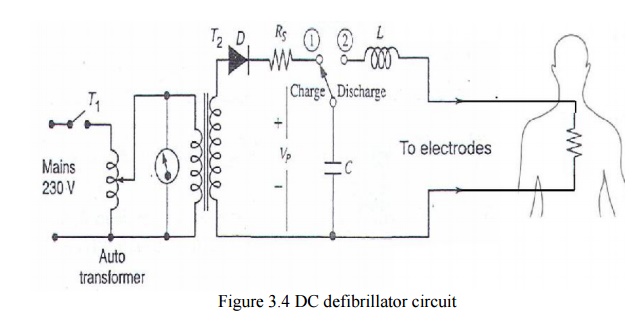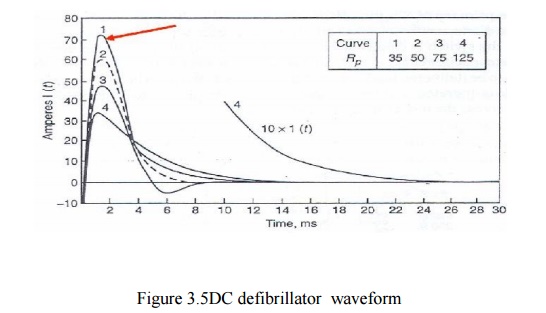Chapter: Medical Electronics : Assist Devices and Bio-Telemetry
DC Defibrillation
DC DEFIBRILLATION
INTRODUCTION
·
To overcome the disadvantage of defibrillation
method In 1962,Bernard lawn from Harward school of public health and peter bent
of Brigham hospital developed a new method known as dc defibrillation.
·
In this dc defibrillation method , a capacitors
charged to a high dc voltage and then rapidly discharged through electrodes
across the chest of patient.
·
DC defibrillation is capable of correcting both the
atrial fibrillation and ventricular fibrillation.
·
DC method produces some harm to the patient.
Depending on the energy setting in the defibrillator , the amount of electrical
energy discharged by the capacitor ranges between 100 to 400 joules. Discharge
portion is approximately 5 ms.
·
In discharge waveform ,the peak value ofs current
is nearly20 A and the wave is monophasic in nature.
·
Monophasic means most of the excursion of curve is
above the base line.

Energy
level of a defibrillator can be controlling:The voltage amplitudeVPof the defibrillator by varying the
setting onthe varactor or Duration of the defibrillator pulse. The energy (WA) stored in the capacitor C and available for the defibrillation
is:
Lown
waveform: Curve 1 shows a typical
discharge pulse of defibrillator which called ―Lown waveform.
I rises
rapidly to app. 20 A
Then I
decays to 0 with 5 ms
A
negative pulse is produced for 1 to 2 ms
The pulse
width defined as the time that elapses between the start of the impulse and the
moment that the current intensity passes the zero line for the first time and
changes direction (5 ms or 2.5 ms)

DUAL PEAK DC DEFIBRILLATOR
If peak
voltage is as high as 6000V is used there is a possibility of damaging
myocardium and the chest walls.
·
Produce dual peak wavereform of longer duraoltation
at lower voltage.
·
Effective defibrillation is achieved in adults with lower level of
delivered energy.
·
Energy range is between 50 to 200W-sec or joules.
·
Effective defibrillation at the desirable lower
voltage levels is also possible with the truncated waveform.
·
The amplitude of the waveform is relatively
constant, but is varied to get required energy.
·
Large electrodes are used for the proper delivery
of large current through the surface of the skin.
·
These electrodes are called as paddles .
EXTERNAL DEFIBRILLATOR:
·
A unit based on computer technology and designed to
analyze the heart rhythm itself, and then advise whether a shock is required.
·
It is designed to be used by lay persons, who
require little training.
·
It is usually limited in their interventions to
delivering high joule shocks for VF
and VT rhythms
·
The automatic units also take time (generally 10-20
seconds) to diagnose the rhythm, where a professional could diagnose and treat
the condition far quicker with a manual unit.
·
Automated external defibrillators are generally
either held by trained personnel who will attend incidents, or are public
access units which can be found in places including corporate and government
offices, shopping centers, airports, restaurants,
·
AEDS require self-adhesive electrodes instead of
hand-held paddles for the two following reasons:
·
The ECG signal acquired from self-adhesive
electrodes usually contains less noise and has higherquality ⇒ allows
faster and more accurate analysis of the ECG ⇒ better
shock decisions. Hands off‖ defibrillation is a safer procedure for the
operator, especially if the operator has little or no training.

DC DEFIBRILLATOR WITH SYNCHRONIZER
·
Synchronization means, synchronized the working of
the heart with the pacemaker. Synchronized DC defibrillator allows the electric
shock at the right point on the ECG of the patient.
·
Electric shock is delivered approximately 20 to 30
ms after the peak of R wave of patients ECG.

Working
· ECG
waveform is traced from the patient.
R-wave in
the output of ECG amplifier triggers the time delay circuit .It gives the delay
of 30 ms approximately. After that, defibrillator circuit is switched ON. So
that, the
capacitor discharges
the electric shock to the patient’s heart.
· The
moment at which electric shock occurs is noted by producing the marker pulse on
monitoring display.
· This type
of circuit is preferred in cardiac emergencies
· The
sudden cardiac arrest can be treated using a defibrillator and 80 percent of
the patients will be cured from the cardiac arrest if the is given within one
minute of the attack.
Electrodes used for defibrillation
·
These paddles have metal disks of 8 to 10 cm in diameter
for external use.
·
For internal use smaller paddles are used on
infants and children.
·
For external use, pair of electrodes are firmly
pressed against the patients chest.
Need of Insulation Handle
·
To prevent the person applying the electrodes from
accidential electric shock specially insulated handles are provided in the
paddles.
·
When paddles are properly positioned , this
prevents the patient from receiving a shock.
·
In earlier equipment a foot switch is used instead
of thumb switch.
Need of Thumb Switch
·
There is a possibility of someone accidentally
stepping on the foot switch in the excitement of an emergency before the
paddles are placed. So thumb switches are mostly preferred.
Charging of Defibrillators
·
In some defibrillators charging is done by means of
a charge switch located in the front panel of the unit.
·
The charge switch is located in the handle of one
of its paddles.
·
In few defibrillators the charging process begins
automatically after discharge.
Types of Electrodes
Two
electrodes are
Ø Anterior-anterior
Ø Anterior-posterior
·
Anterior-anterior paddles are applied to the chest.
Anterior-posterior paddles are applied to both the patients chest wall and back
so that energy is delivered through the heart.
·
Specially designed pediatric paddles are available
with diameter ranging from 2 to 6 cm.
·
Internal paddles can be either gas-sterilized or
autoclaved.
Indication Meter
·
Most of the defibrillators include a watt second
meter to inducate the amount of energy stored in the capacitor before discharge.
·
The energy indicated on the meter is lost or
dissipated as heat in the components inside the unit.
Related Topics